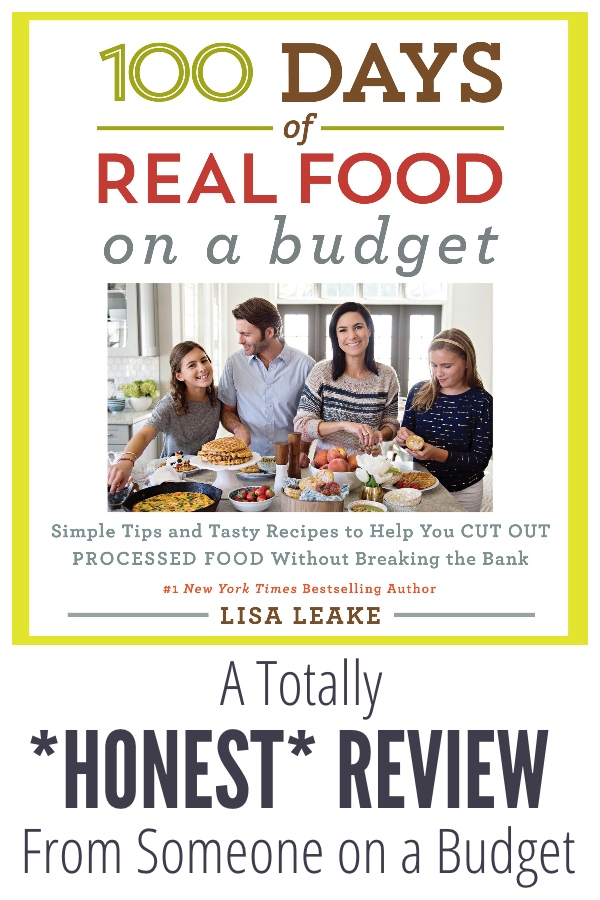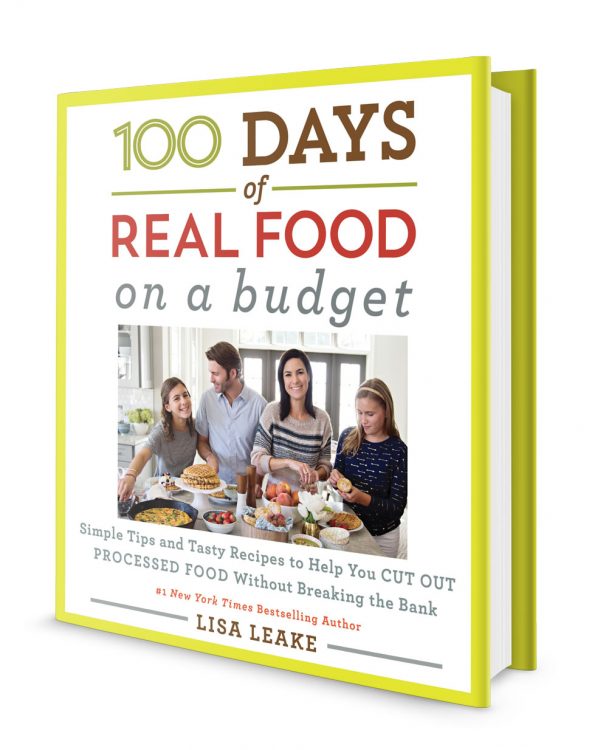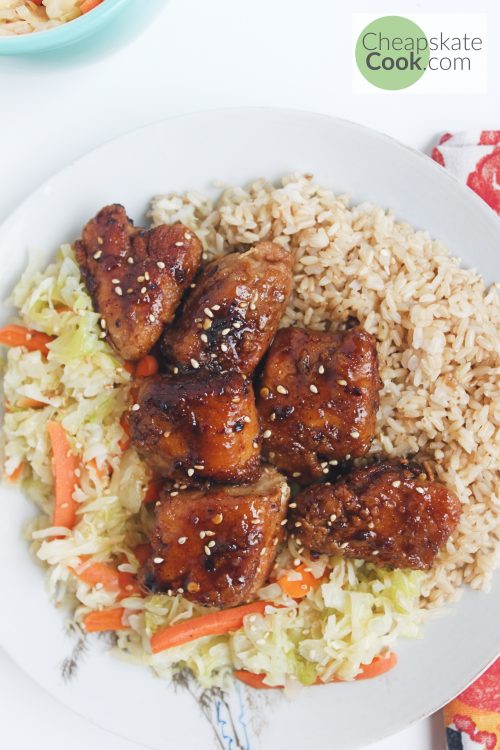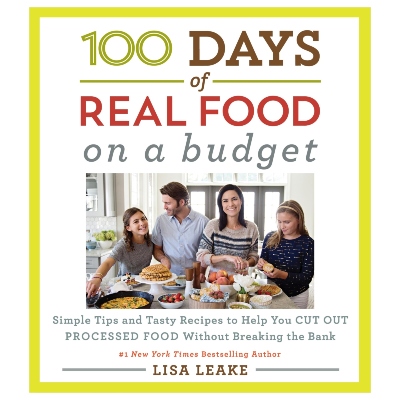Can Lisa Leake’s newest cookbook, 100 Days of Real Food on a Budget, REALLY help you save money and eat healthy? Here’s my totally honest review.

This post contains affiliate links, which means I receive a small compensation if you make a purchase using the links. You can view my full disclosure policy here.
The problem with real food is that it’s expensive and intimidating. If your budget can barely afford Ramen noodles and you start caring about your health, I know your pain.
Thankfully, real food voices heard the cry. A few years ago, I ran across the blog 100 Days of Real Food. They were in the middle of their 100 Days of Real Food on a Budget challenge.
Normally, most recipes and meal plans on the website, though tasty, were far out of reach for my budget.
The budget challenge was different. It was still expensive (I remember reading the posts and just wishing we had $125/week for our family), but the recipes, tips, and concepts were within our grasp.
My Real Food Rules:
Thankfully, real food is a concept, not a brand. Everyone has their own definition and there is no shame or real food police telling you that you’re doing it wrong. Here’s what I think you should do.
1. Keep Learning
Read those books, watch those documentaries, talk to the health-foodies in your life.
2. Do What Works for You
It seems like the health rules keep changing. Everyone has very compelling reasons why you should eat XYZ and avoid ABC. Personally, I avoid sauerkraut like it’s the devil because IT IS. I don’t care how healthy you tell me lacto-fermented cabbage is. I’m sorry.
No judgment if you love it and think everyone should eat it. You’re probably right.
3. Progress
Don’t give up. One step at a time. Even a little progress is progress. All those cliche motivational phrases are true. Progress is progress, and don’t feel guilted into what you should be doing. Do what you can with what you have today.

100 Days of Real Food on a Budget
I was skeptical when I heard about this book (affiliate link). But when I read it I was like, *all the praise hands*. Lisa Leake is all about no shame, no guilt, and here are some tools and yummy ideas – make them work for you. Because if you read this cookbook, this stuff is important to you.
I’ll share what I don’t like about this cookbook first, followed by what I love.
Disclosure: I received a copy of 100 Days of Real Food on a Budget to review. All opinions are my own.
What I Don’t Like:
It’s still expensive. The 7-day dinner meal plans are still around $100/week – just for dinner. But when we were on a really tight budget and eating real food, $100/week on dinners was not an option.
On one hand, you can certainly swap some of the dinners for plant-based beans and rice meals – and remember you’ll probably have leftovers.
On the other hand, that means I can’t actually use the meal plans – because they are just too expensive.
“Budget” is Relative
While reading this book, I had to keep in mind that many people who love real food spend far more than $150/week for a family of 4.
But I know a lot of people who try to eat real food and can’t begin to spend that much. I hoped that 100 Days of Real Food on a Budget would be an answer.
Cost per Meal
Every meal in the book costs less than $15 to serve a family of 4. That’s great news! But many people can’t afford to spend $15 for breakfast alone.
This cookbook has lots of tasty, budget-minded recipes that would be a fun supplement to the classic cheap real food breakfasts, like oatmeal or eggs and fruit. (Baked oatmeal, leftover veggie frittata, and tiny bits of 4-ingredient sausage are our mainstays here.)
In the end, like when I first stumbled across their website, I found myself frustrated by recipes and ingredients that are out of reach for many passionate real-foodies.

Easy Real Food Chinese Chicken from the Cookbook – delicious!
What I Do Like:
That being said, 100 Days of Real Food on a Budget is a treasure-trove of budget-friendly tips and recipes for anyone who feels like they spend too much on groceries and needs to slash their costs.
1. Recipe Price Lists
Here’s a quote from the book:
I’ve seen other budget recipes that call for 3 tablespoons of sour cream, worth only 20 cents. But when was the last time you could buy only 3 tablespoons of sour cream? I’ve taken the liberty of listing the total cost of ingredients for a recipe, whether you use them all up or not. If you don’t have the extra money to spend on the rest of the sour cream container, you simply don’t have it.
– Lisa Leake, 100 Days of Real Food on a Budget, p. 4
So this factors into the overall costs of the $15 recipes – and makes the whole concept more affordable!
2. Cost Wiggle Room
In the Introduction, Lisa says very clearly that the ingredient costs were from Publix – a store not known for super low prices – and none of them were on sale. She did that because she wanted plenty of wiggle room for people to trim costs by savvy shopping – but still know they have reasonably-priced meals if they can’t get ingredients on sale.
So even though the price list in the cookbook is $15.28, if you shop sales, freeze, and substitute ingredients, your cost may be much smaller.
3. Price Comparison Sheets
Obviously, prices change over time and where you are in the world, but it’s still really helpful! Price comparison sheets for grocery stores are intimidating, and Lisa did all the work for us.
4. Ingredient Swap Sheet
One of the best ways to save money and eat healthy is to find tasty, inexpensive substitutes. There’s a whole page dedicated to listing some of my favorites: boneless chicken thighs instead of breasts, cream cheese instead of goat cheese – even the cost savings per pound!
5. Allergy-Friendly Recipes!
Yay! Here’s a breakdown of how many recipes are allergy friendly.
6. The Recipes
Of course. Lisa always shares tasty recipes, and I can’t wait to make ALL OF THEM. With her permission, I shared one here.
Should You Buy This Cookbook?
Like I said, If you love real food and feel like you spend too much on groceries, 100 Days of Real Food on a Budget is a treasure-trove of budget-friendly tips and recipes.
If you have a normal-size grocery budget, and you’re just beginning to eat real food, this cookbook is the perfect way to start without blowing your budget into oblivion.
However, if you’re on a tight budget (think less than $100/week for a family of 4), Lisa Leake’s newest cookbook might leave you more frustrated than inspired. It’s still a great read and loaded with tips that you can use to save money and eat healthy.
If that’s you, I highly recommend at least borrowing a copy from the library. Find those recipes and ideas that will work for you. Just know that it probably won’t be the answer to all of your real food budgeting needs.
In the end, 100 Days of Real Food on a Budget answers the financial debacle for many passionate real-foodies, while leaving some of us out in the dark. Which is fine, honestly. One cookbook can’t work for everyone.
If you’re struggling to save money and eat healthy, keep learning, keep doing what works for you in this season, and keep making progress. You are doing a good job.
What You Can Do Now:
If you found this review helpful, let us know! Leave a comment, share the review on Facebook or Pinterest, and follow us on Instagram for more reviews and frugal recipes.
We also share cheap (like, actually cheap), real food menu plans every month for FREE with our email subscribers. Get the next one here.


Trackbacks/Pingbacks